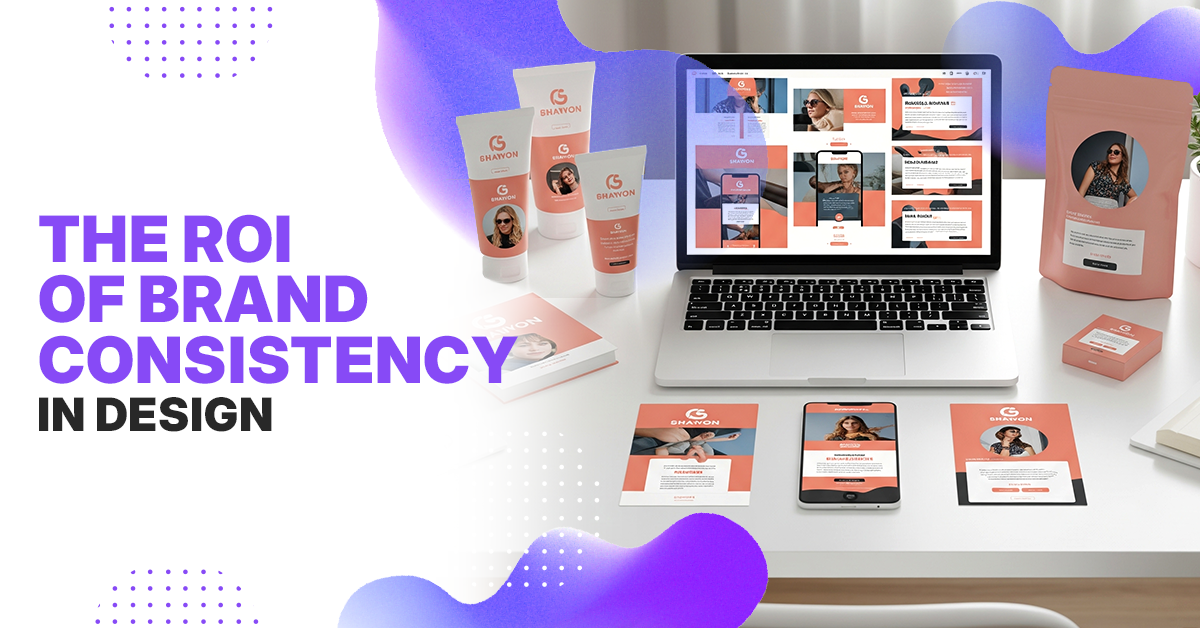As a founder or business owner, you’ve carefully crafted the essence of your Branding Package Design, which is crucial in establishing your brand as seamless and memorable. Whether you are introducing a new brand or reinventing an established one, your branding package acts as the linchpin to your visual image and communication profile.
It communicates how your brand appears, senses, and resonates with people, ensuring uniformity across platforms. Here in this blog, we will guide you through what to put in a branding package—and what to exclude.
However, the challenge lies in effectively communicating these essential brand values to your team, ensuring that every member is aligned with the brand’s ethos and can translate it into their actions.
To make this process easier, a branding package is used. Your brand’s communication package serves as a guidebook for everything that happens online and offline.
What is a Branding Package?
Imagine you have a cool treasure box. Inside, you keep your favorite toys, colors, and stickers—everything that makes you, well, you! Similarly, a branding package is like a special box for a company. It contains all the elements that make the company unique and easily recognizable.
This includes the company’s logo variations, color palette, typography, and even how they communicate with you (i.e., communication guidelines).
Why is a Branding Package Necessary?
Think about your favorite superhero. Iron Man, perhaps? Now, Iron Man has a special suit with cutting-edge technology, right? The suit and its features represent his brand!
Just like the suit helps Iron Man fight villains and save the day, a branding package helps a company stand out and be memorable in the vast world of business.
Imagine if every time you saw Iron Man, he wore a different suit and looked different. That would be confusing, right? Similarly, if a company keeps changing its logo, colors, and the way it presents itself, it confuses people.
A branding package keeps things consistent and clear, so you always recognize your favorite superhero… or your favorite brand!
What to Include in a Branding Package?
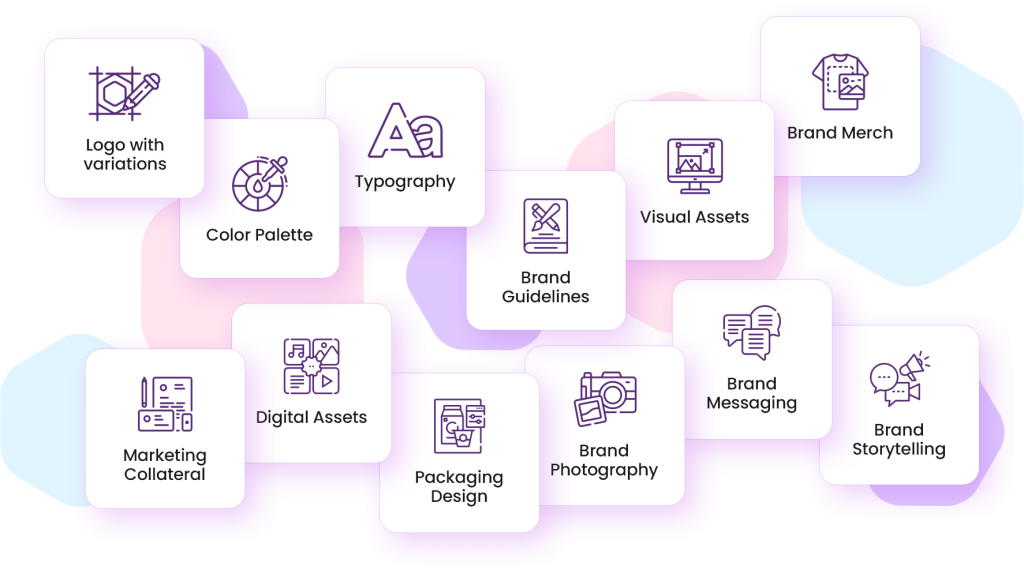
Logo with Variations
In a branding package, a crucial element is a versatile logo with variations. A logo visually represents a brand and is essential for shaping its identity. Variations in a logo provide flexibility, allowing adaptation to different platforms and contexts while maintaining consistency.
They ensure the logo looks compelling and recognizable across various mediums, from digital platforms to print materials. Different versions aid in brand recognition and recall, fostering a strong brand association.
To maximize the impact of logo variations, it’s essential to understand the brand story and target audience. Diversifying color schemes and ensuring design scalability are critical. Tailoring variations for specific contexts and seeking professional design assistance can significantly enhance brand identity.
Color Palette
A well-defined color palette offers several benefits. Firstly, it enhances brand recognition, as consistent colors across touchpoints create a strong association with the brand. Secondly, colors evoke specific emotions and convey the brand’s personality, fostering a deeper connection with the audience.
Lastly, a consistent color palette maintains visual uniformity, reinforcing the brand’s identity and professionalism across various platforms.
To create an effective color palette, start with in-depth research on color psychology and industry trends. Analyze how different colors align with your brand’s message and target audience.
Choose a set of harmonious colors that resonate with your brand’s values and objectives, ensuring they work well across digital and print mediums. A well-thought-out color palette is a crucial component in creating a memorable and impactful brand identity.
Typography
In a branding package, typography plays a pivotal role in conveying a brand’s personality and message. It involves selecting and arranging fonts that align with the brand’s identity, reinforcing its uniqueness, and enhancing overall design consistency.
Typography influences how the audience perceives a brand. Fonts have distinct characteristics—bold, elegant, playful—which must harmonize with the brand’s values. Consistent use of selected fonts in marketing materials, websites, and other brand elements cultivates a cohesive and memorable brand image.
To effectively utilize typography, research and select fonts that mirror your brand’s tone and resonate with your target audience. Establish primary and secondary fonts for various use cases, ensuring readability and visual appeal. Well-considered typography elevates your brand’s communication, creating a distinct and lasting impression on consumers.
Brand Guidelines
Brand guidelines within a branding package act as the compass for maintaining a cohesive brand identity. They define and standardize the usage of essential brand elements like logos, colors, typography, tone of voice, and imagery across all brand communications and materials.
The significance of brand guidelines lies in ensuring consistency and presenting a unified brand image. They provide clarity and specific instructions for proper brand representation, aiding internal and external stakeholders in maintaining coherence.
Additionally, brand guidelines enhance efficiency by streamlining design processes and facilitating seamless collaboration.
To create effective brand guidelines, cover all crucial aspects of branding comprehensively. Detail the appropriate use of logos, precise color codes, typography rules, and guidelines for maintaining a consistent tone and voice.
Visual Assets
Visual assets are foundational elements within a branding package, encompassing images, graphics, videos, and other multimedia components that significantly enhance a brand’s appeal and resonance. These visual elements serve to vividly convey the brand’s essence, values, and personality to the audience, making a memorable and lasting impression.
Incorporating a cohesive and compelling set of visual assets is pivotal for effective brand storytelling. Visuals can evoke emotions, convey complex ideas, and capture attention in a way that words alone cannot. When crafted meticulously, visual assets align seamlessly with the brand’s messaging, reinforcing its identity and creating a recognizable visual language.
By leveraging visual assets strategically across various platforms such as websites, social media, advertisements, and marketing materials, brands can ensure consistent communication and a strong brand presence.
Brand Merchandise – T-shirts, Mugs, Notebooks, Water Bottles, Branded Bags
Brand merchandise extends a brand’s reach beyond the digital realm, making the brand a tangible and memorable part of a customer’s everyday life.
When strategically designed and distributed, brand merchandise acts as a mobile marketing tool. Consumers who wear branded items become walking advertisements, showcasing the brand to a wider audience. This not only fosters brand recognition but also cultivates brand loyalty and a sense of community among customers.
Additionally, brand merchandise reflects the brand’s personality and values. Each item becomes a canvas for expressing the brand’s aesthetic, creating a strong connection with the consumer.
From apparel to accessories, brand merchandise embodies the brand’s essence, enhancing visibility and leaving a lasting, positive impression on both existing and potential customers.
Marketing Collateral
Marketing collateral within a branding package refers to an array of print or digital materials, such as brochures, flyers, business cards, and banners, designed to effectively communicate a brand’s message and offerings. These materials are crucial touchpoints that provide detailed information about the brand, its products, and its values.
Crafting marketing collateral with precision and aligning it with the brand’s visual identity is paramount. Consistent use of the brand’s colors, typography, imagery, and messaging reinforces brand recognition and trust. Whether distributed physically or digitally, well-designed marketing collateral acts as a persuasive medium, influencing potential customers and fostering brand loyalty.
By adhering to brand guidelines and maintaining a cohesive design, marketing collateral becomes a powerful tool in building brand identity, driving engagement, and effectively communicating the brand’s essence.
Digital Assets
In this digital age, most users will encounter your brand online. Defining digital assets in a branding package is necessary. Strategically crafted digital assets are utilized across websites, social media platforms, email marketing, digital advertising, and other online channels to convey the brand’s story, values, and offerings effectively.
Thoughtfully created digital assets captivate the audience, convey information, and drive engagement. Whether it’s compelling visuals or informative videos, these assets are designed to leave a lasting impression, ultimately influencing brand awareness, customer engagement, and loyalty in the highly competitive digital landscape.
A robust set of digital assets is instrumental in establishing a compelling and recognizable brand identity in the digital realm.
Packaging Design
Packaging design, a vital aspect of a branding package, has a profound impact on how consumers perceive a product and the brand itself. It involves the design and layout of the product’s packaging, carefully considering aesthetics, functionality, and brand representation.
An effectively designed package serves as the first point of physical interaction between the consumer and the brand. It should seamlessly integrate with the brand’s visual elements, color schemes, typography, and overall messaging.
Consistency in packaging reinforces brand identity and fosters brand loyalty. Moreover, a captivating and well-designed package tells a story, communicates product benefits, and sets the brand apart from competitors on store shelves or in the online market.
From the choice of materials to the design elements, packaging creates a unique brand experience. It is an opportunity to connect emotionally with consumers, influence purchasing decisions, and leave a lasting positive impression.
Brand Photography
In a branding package, professional and cohesive brand photography is paramount for conveying the brand’s essence and creating an emotional connection with the audience. Well-planned photoshoots ensure that the brand’s visual identity is maintained consistently across all marketing channels and materials.
Brand photography extends beyond product shots; it encompasses lifestyle imagery, corporate headshots, event coverage, and more. Each photograph should tell a story, evoke emotions, and embody the brand’s values and personality.
Investing in high-quality brand photography ensures that the brand is presented in the best possible light, resonating with the target audience and establishing a strong and memorable brand image. It’s a powerful tool for creating a lasting impression and reinforcing the brand’s narrative in the minds of consumers.
Brand Messaging
Brand messaging is the expression of the brand’s values, beliefs, value propositions, and overall personality. It encompasses taglines, slogans, mission statements, and any content that carries the brand’s name.
In a branding package, clear and consistent brand messaging is crucial for establishing a cohesive brand identity. It should mirror the brand’s personality, values, and unique selling propositions, effectively communicating what sets the brand apart from competitors. Well-crafted brand messaging engages the audience, helps in building a strong emotional connection, and contributes to a compelling brand story.
Effective brand messaging transforms the brand from being a mere entity into a relatable and enduring part of the audience’s lives, ultimately influencing consumer perception and fostering brand loyalty.
Brand Storytelling
While brand messaging is focused on delivering concise and strategic messages to convey a brand’s essence and differentiation, brand storytelling is about engaging the audience with a captivating narrative that emotionally connects them to the brand’s journey and values.
Consistent storytelling across various brand touchpoints, including websites, social media, marketing materials, and advertisements, weaves a consistent and memorable brand narrative, fostering a deeper understanding and resonance with the target audience.
Effective brand storytelling humanizes the brand, allowing the audience to connect on a personal level. It helps convey the brand’s values, beliefs, and the impact it aspires to make in the world. Well-crafted brand stories evoke emotions, inspire action, and position the brand in the hearts and minds of consumers, making the brand more than just a product or service—it becomes a meaningful and enduring part of their lives.
What to Exclude in a Branding Package & Mistakes to Avoid While Designing One
Irrelevant/Inconsistent Elements

In a branding package, eliminating irrelevant and inconsistent elements is vital for an impactful brand identity. Avoid including elements that don’t directly contribute to conveying the brand’s essence or message.
Inconsistency in design, color schemes, typography, or tone can dilute the brand’s image and confuse the audience. Streamline the package to focus on only essential elements that effectively represent the brand and resonate with the target audience.
A cluttered or inconsistent branding package can misrepresent the brand, making it essential to carefully curate and exclude elements that do not align with the brand’s identity and objectives.
Generic or Stock Materials

Utilizing generic or stock materials in a branding package can hinder brand distinctiveness and dilute the brand’s unique identity. Avoid incorporating overused, readily available images, templates, or content that fail to set your brand apart. These materials lack originality and can convey a sense of inauthenticity to the audience.
Opt for custom and tailored design elements to ensure that your branding package reflects the brand’s unique character, values, and message accurately. Strive for originality and authenticity in every aspect of the branding package to establish a strong and memorable brand presence that stands out in the competitive market.
Unapproved/Excessive Variations

Including unapproved or excessive variations in a branding package can undermine brand consistency and dilute its impact. It’s crucial to exclude any versions of logos, color schemes, or fonts that the brand guidelines have not authorized.
Uncontrolled variations can lead to a fragmented brand image, causing confusion among the audience and weakening brand recognition. Additionally, an excessive array of variations may overwhelm and divert focus from the core brand identity. Streamlining variations to a controlled, approved set ensures a cohesive and professional brand presentation.
The branding package should only showcase a well-curated selection of variations that align with the brand’s guidelines, effectively conveying the brand’s message, personality, and values.
Excessive Information
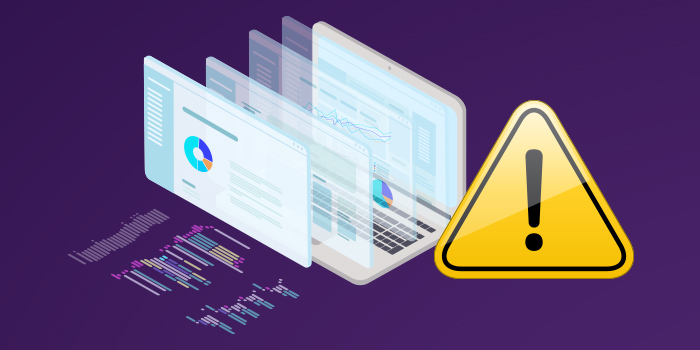
Excessive information tends to complicate the process of interpreting and implementing brand guidelines. Team members and stakeholders may struggle to discern vital instructions, resulting in inconsistencies in design, messaging, or visual representation. This can ultimately lead to a fragmented brand identity, harming brand recognition and cohesion.
For a brand to maintain a strong and unified image, it’s imperative to streamline and prioritize information within the branding package. Clear, concise, and actionable guidelines empower teams to execute branding strategies with precision, ensuring a consistent brand identity across all touchpoints.
A clutter-free, focused branding package simplifies compliance, making it easier to convey the brand’s story, values, and message effectively.
Unlicensed Fonts or Images
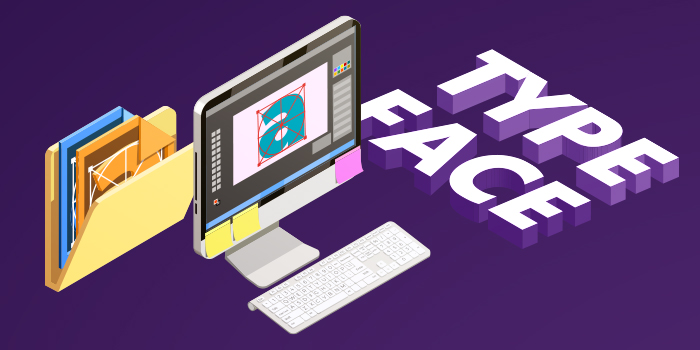
Unlicensed fonts or images can potentially lead to legal complications and reputational damage for the brand. Using fonts or images without proper licensing infringes on intellectual property rights and violates copyright laws.
Unlicensed assets compromise the brand’s credibility and professionalism. They may not align with the brand’s intended message or design standards, resulting in a disjointed and inconsistent brand representation.
Moreover, if legal issues arise due to the use of unlicensed materials, it can lead to financial penalties and legal battles, tarnishing the brand’s reputation and eroding trust with stakeholders.
To uphold the brand’s integrity and legal standing, it is crucial to exclude any unlicensed fonts or images from the branding package.
Negative or Controversial Content

Negative or controversial content can provoke strong reactions and backlash from the public, social media, or advocacy groups. It can divert attention from the brand’s core values and messaging, leading to a distorted brand narrative.
To safeguard the brand’s reputation and maintain a harmonious relationship with its audience, it’s imperative to exclude any negative or controversial content from the branding package.
Brands should focus on promoting a positive, inclusive, and respectful brand image that aligns with their values and resonates with their target audience, fostering long-term brand loyalty and a strong market presence.
Incomplete or Inaccurate Information
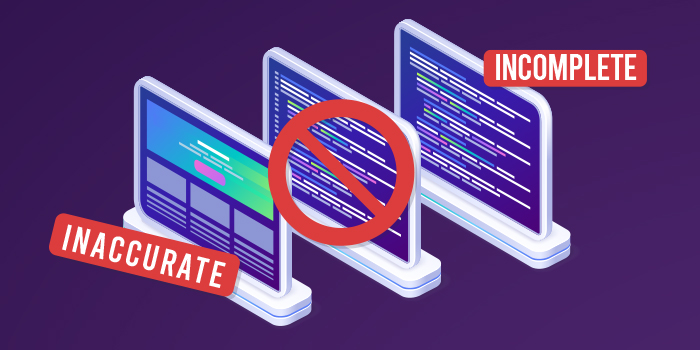
Incomplete information leaves gaps in the brand narrative, making it difficult for consumers to fully understand the brand’s vision, mission, and values. This lack of clarity can result in inconsistent branding efforts, as team members may interpret or convey the brand’s message incorrectly.
Inaccuracies further complicate this issue, as they can misrepresent the brand, leading to brand identity confusion among both internal and external stakeholders.
Such inefficiencies can trigger a ripple effect, impacting marketing campaigns, product launches, and customer interactions.
To maintain an efficient branding process, it is crucial to exclude any incomplete or inaccurate information from the branding package.
Get Expert Help from Design Shifu for Your Branding Package
Design Shifu should be your go-to solution for a comprehensive branding package that doesn’t strain your budget. We deliver unlimited graphic design services tailored to meet all your branding needs without breaking the bank.
At Design Shifu, we excel in crafting compelling logo designs, web and app layouts, email templates, business cards, newsletters, and more, ensuring you have a complete branding arsenal at your disposal.
Our pricing model, designed with your convenience in mind, sets us apart. For a flat monthly rate, request as many design assets as you need, from logos to flyers to package designs, and pay just one fixed price each month.
Don’t let cost barriers hinder your path to a remarkable branding package that drives revenues. Sign up for Design Shifu today and experience the difference. Ready to elevate your brand? Book a demo now and let our designers bring your vision to life.





